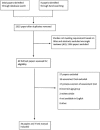Psychometric properties of gross motor assessment tools for children: a systematic review
- PMID: 30368446
- PMCID: PMC6224743
- DOI: 10.1136/bmjopen-2018-021734
Psychometric properties of gross motor assessment tools for children: a systematic review
Abstract
Objective: Gross motor assessment tools have a critical role in identifying, diagnosing and evaluating motor difficulties in childhood. The objective of this review was to systematically evaluate the psychometric properties and clinical utility of gross motor assessment tools for children aged 2-12 years.
Method: A systematic search of MEDLINE, Embase, CINAHL and AMED was performed between May and July 2017. Methodological quality was assessed with the COnsensus-based Standards for the selection of health status Measurement INstruments checklist and an outcome measures rating form was used to evaluate reliability, validity and clinical utility of assessment tools.
Results: Seven assessment tools from 37 studies/manuals met the inclusion criteria: Bayley Scale of Infant and Toddler Development-III (Bayley-III), Bruininks-Oseretsky Test of Motor Proficiency-2 (BOT-2), Movement Assessment Battery for Children-2 (MABC-2), McCarron Assessment of Neuromuscular Development (MAND), Neurological Sensory Motor Developmental Assessment (NSMDA), Peabody Developmental Motor Scales-2 (PDMS-2) and Test of Gross Motor Development-2 (TGMD-2). Methodological quality varied from poor to excellent. Validity and internal consistency varied from fair to excellent (α=0.5-0.99). The Bayley-III, NSMDA and MABC-2 have evidence of predictive validity. Test-retest reliability is excellent in the BOT-2 (intraclass correlation coefficient (ICC)=0.80-0.99), PDMS-2 (ICC=0.97), MABC-2 (ICC=0.83-0.96) and TGMD-2 (ICC=0.81-0.92). TGMD-2 has the highest inter-rater (ICC=0.88-0.93) and intrarater reliability (ICC=0.92-0.99).
Conclusions: The majority of gross motor assessments for children have good-excellent validity. Test-retest reliability is highest in the BOT-2, MABC-2, PDMS-2 and TGMD-2. The Bayley-III has the best predictive validity at 2 years of age for later motor outcome. None of the assessment tools demonstrate good evaluative validity. Further research on evaluative gross motor assessment tools are urgently needed.
Keywords: gross motor assessment; paediatrics; rehabilitation medicine; reliability; validity.
© Author(s) (or their employer(s)) 2018. Re-use permitted under CC BY-NC. No commercial re-use. See rights and permissions. Published by BMJ.
Conflict of interest statement
Competing interests: None declared.
Figures



References
-
- World Health Organization. International classification of functioning, disability and health: ICF. Geneva: World Health Organization, 2001.
Publication types
MeSH terms
LinkOut - more resources
Full Text Sources
Medical
Miscellaneous
